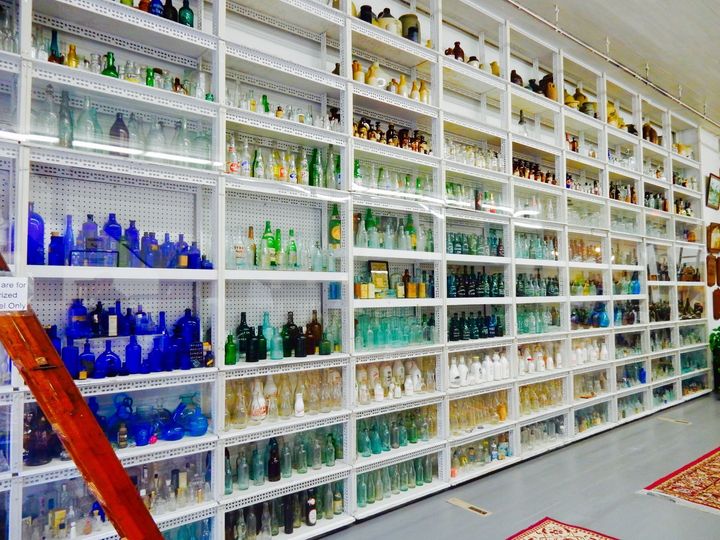
National Bottle Museum, Ballston Spa NY
A museum that features one of the most iconic movies in American history. Another that celebrates mid-century modern neon in a shoreline resort town. A playground for math nerds, small institutions devoted to golf, shipwrecks, musical mechanical instruments, and even Jimmy Stewart. All of these, and more, have one thing in common: they are often overlooked by tourists, but shouldn’t be. More information on the following 45 small to gargantuan museums below can be found on GetawayMavens.com, your source for the “Best Offbeat Escapes in the Northeast.”
VERMONT
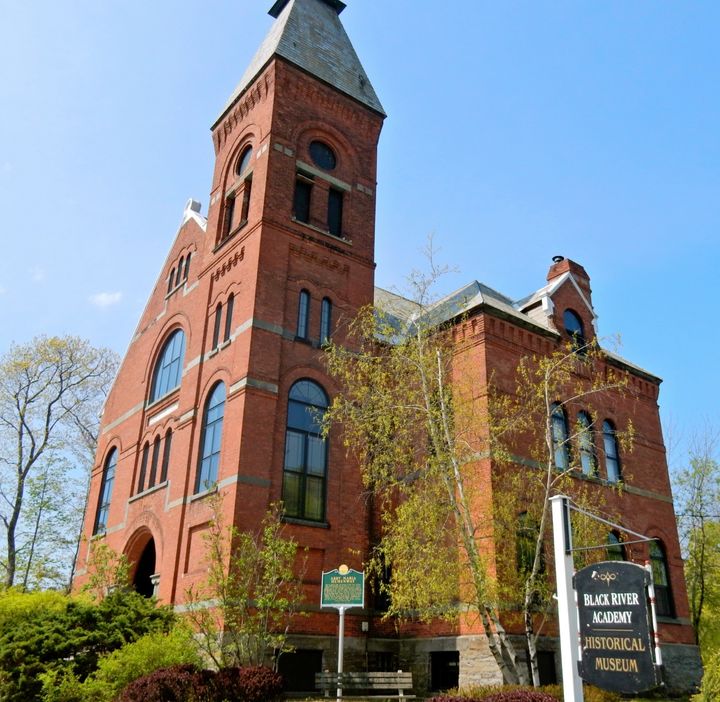
Black River Academy, Ludlow VT
Ludlow: Black River Academy Museum and Historical Society, Ludlow. Built in 1888, Black River Academy drew male and female students from 158 towns, 26 states and even Cuba. One was our 30th President, Calvin Coolidge. A rare co-ed school for its day, Black River saw its last graduating class in 1938 when a new High School was built in town. After a stint as a nursing home and then vacant from 1968-1972, the Richardsonian – Romanesque Style building was preserved and opened as a museum in 1973. This place is worthy of at least an hour – more so for what has not changed. Here, it’s not the walls that talk, but the stairs, worn and warped where hundreds of feet trudged or skipped up and down (hugging the right-hand side each way). A short video shines a light on student life here, including the many pranks the kids would pull. In one case, a donkey was led upstairs into a classroom. Who did it? When asked, the young Coolidge did not confirm or deny.
Manchester: American Museum of Fly Fishing, situated right next door to the Orvis Flagship Store, you’ll be surprised how many US presidents waxed lyrical about fly-fishing (among them, Eisenhower and George H W Bush). Read how they extolled the sport, and learn about this solitary, meditative activity through a time-line history at this quaint, information packed museum. Upstairs, you’ll find books on fly-fishing in the wood paneled Gardiner Grant Library, and for a quarter, you can watch how a “Line Braider” machine works.
MASSACHUSETTS
Nantucket: Nantucket Historical Association Whaling Museum. The skeleton of a 46 ft bull sperm whale hovers perilously over a harpoon packed whaling skiff – the centerpiece of this engaging institution. Over the past few decades, this once small whaling museum has expanded into a world-class institution, run by the noteworthy Nantucket Historical Association, which also manages several other worthy historic sites on the island. The unfortunate whale washed ashore nearby on January 1, 1998, and despite attempts to revive it, the whale died (most likely from a tooth infection). Now, the bones of this monster best demonstrate what whaling crews had to harpoon and wrestle with to prepare for processing. The Historical Association also manages Greater Light, the home of a couple of eccentric Quaker sisters, Philly born Gertrude and Hannah Monaghan, who never married and, in 1930, converted an old livestock barn into a “found object” work of art; Fire Hose Cart House, a small barn built in 1886 - the last remaining 19th century firehouse on the island; the 1686 Jethro Coffin House – the “Oldest House in Nantucket in its Original Location; the Old Gaol, pronounced “jail,” a 1805 Garrison-style prison considered one of the oldest in the country; and Old Mill - built in 1756, this Dutch windmill is the oldest functioning mill in the United States open for tours and demonstrations.
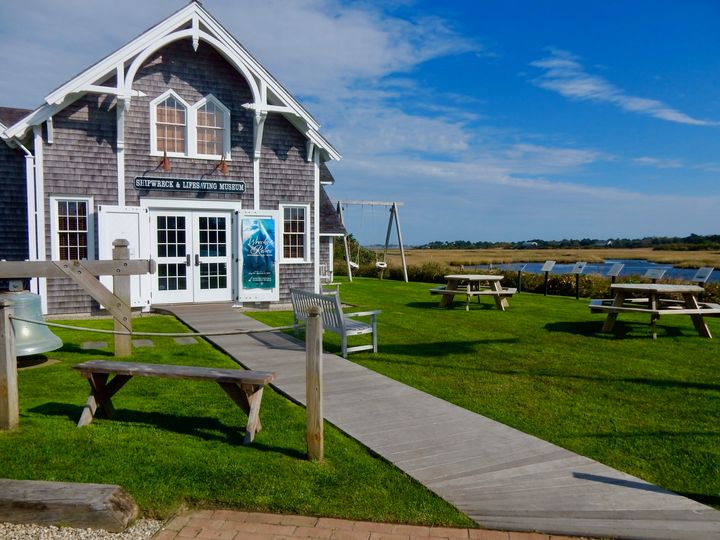
Shipwreck and Lifesaving Museum, Nantucket MA
Nantucket: Egan Maritime Shipwreck and Lifesaving Museum. A bit out of town, this fantastic museum, celebrating its 50th and 10th anniversaries (first for its initial opening, second for its 2007 expansion) is worth the bike ride, or even a taxi ride to see. Shoals surround this 14-mile long crescent moon shaped island: over 700 ships have run aground around Nantucket – and continue to do so. Nantucket has been a magnet for shipwrecks since men set off in ships: the last one in 1995, when the Panamanian cruise ship Royal Majesty lost its bearings and ran aground on the Rose & Crown shoals (floating off, without any injuries, at high tide).
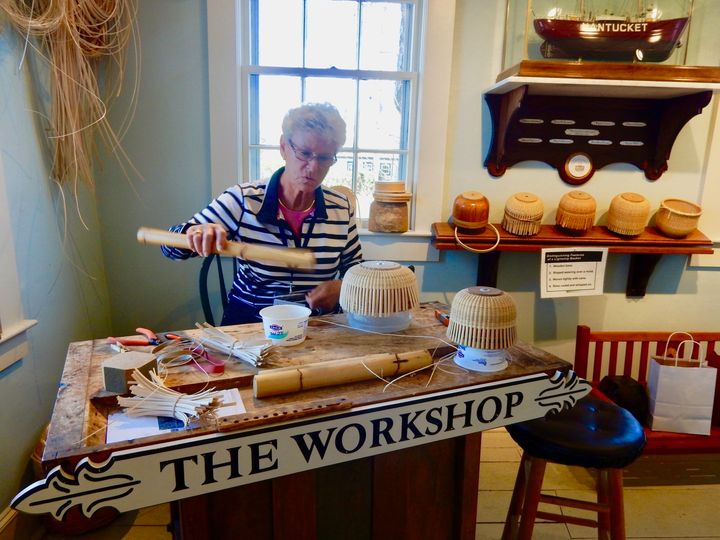
Nantucket Lightship Basket Museum Nantucket MA
Nantucket Lightship Basket Museum. The Nantucket Lightship Basket is easily identifiable the world over, though you have to come to Nantucket (or order online from here) to obtain this truly authentic piece of folk art. The woven baskets made from strips of rattan brought back to Nantucket on Pacific-Island-bound whaling ships were first painstakingly fashioned in the 1870’s by men manning the Nantucket Lightship – essentially a floating lighthouse. What came to be known as “Lightship Baskets” were initially given to wives and used to carry crops from fields and gardens.
NEW YORK
Manhattan: Fashion Institute of Technology (FIT) Museum. Not for nothing is 7th Ave. dubbed “Fashion Ave.” – and that’s where you’ll find this design tech college and its very accessible museum (at 27th St). The museum’s permanent collection includes 50,000 historically significant garments from the 18th century to modern times, with intimate galleries and well-thought-out themes. Temporary exhibits showcase innovative and student-designed clothing. Best of all, entrance is free.
Manhattan: Museum of Mathematics aka MoMath, 28th and 5th. Though it may sound a tad academic, the innovative and interactive MoMath is a two-floor playground for number nerds and, too, for those who claim to have no faculty for figures. Despite aptitude, all who enter here will thrill at driving a car on a mobius strip, running through virtual “gates,” sinking basketballs, and peddling a trike with square wheels, along with many more mathlete-approved merriments.

Spinney Clock Museum, Port Jefferson NY
Port Jefferson (on Long Island): The Spinney Clock Collection at the Mather House. In the 1960’s, electrical engineer, Ross Spinney, began to collect antique clocks from all over the globe – most in disrepair. By the time Spinney died in 1984, he’d amassed 910 of them, which he, while alive, displayed in his own home. Before his death, Ross told his wife, Tex, to sell them off and travel around the world, which she did, one by one, until her death in 2016. The 200 that remain are on display in this wondrous place where each clock from England, France, Sweden, Germany, and of course the USA, is a work of art.
Saratoga Springs: Saratoga Automobile Museum. Stand before the crushed remains of a Port Authority K-9 Bomb Detection Police Jeep, used by David Lim and his canine partner, Sirius, on 9-11. Lim survived, but his trusty dog, Sirius, died in the line of duty. You’ll see vehicles both poignant and cheeky in this intriguing, bite-size, and very accessible antique auto museum – located in the former Saratoga Natural Mineral Waters Bottling Plant within the greater Saratoga State Park. Make a point to spend at least half an hour here to see cars and trucks in two floors of galleries that don’t overwhelm.

NY State Military Museum, Saratoga Springs NY
Saratoga Springs: : New York State Military Museum and Veterans Research Center. Whether you’re interested in Military History, Women’s history, African-American History or even graphic art from 100 years ago, this impactful museum has something for everyone. Starting with the Revolutionary War Battle of Saratoga through the war in Iraq, the NYSMM focuses on and pays tribute to New York State’s contribution to the country’s military history.
Ballston Spa: National Bottle Museum. It’s just about 7 miles from downtown Saratoga, but devotees of the offbeat will want to check out this collection of hand-made glass bottles from the early 1700’s to 1903, when industrial machines took over. Why here? Those who believe that Boomers and Gen-Xer’s started the artisanal sparkling water craze (Perrier, anyone?), think again: between 1823 and 1889, mineral waters from about 30 springs in Saratoga County were bottled and distributed around the world. These special bottles were designed to withstand internal gas pressure and rough handling during shipment – and their distinctive design came to be known as Saratoga-bottle.
Elmira: Chemung Valley History Museum. This region is replete with important history – both natural and man-made. You’ll find “The Big Horn” Mammoth Tusk from one of many Mastodons who roamed upstate New York 11,000 years ago, and plenty of artifacts and photos from the Langdon and Samuel Clemens families. During the winter of 1864/65, the Elmira Prison Camp interred over 12,000 Confederate Troops. Nearly 3,000 died from Smallpox, a harsh winter, and shortage of food.
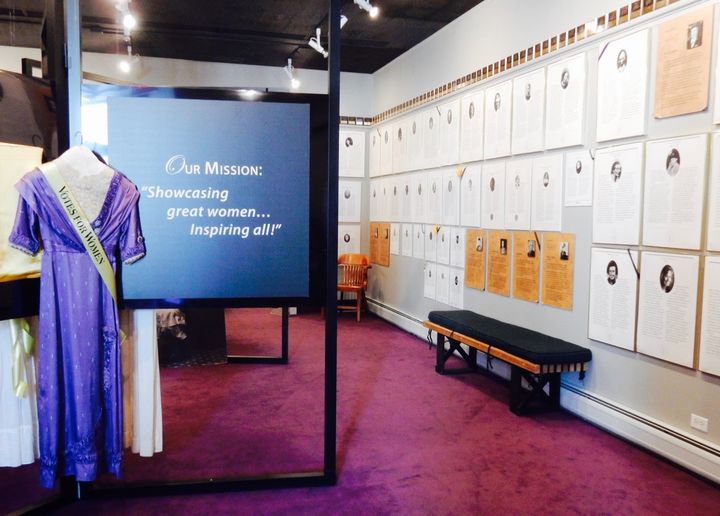
National Women’s Hall of Fame, Seneca Falls NY
Seneca Falls: National Women’s Hall of Fame – soon to be Center For Great Women. This museum’s mission – “Showcasing great women, inspiring all” was long in coming. Twenty women were first inducted in 1973, and now over 266 women – in politics, science, business, sports, arts, and entertainment – are showcased here, among them, Abigail Adams, Maya Angelou, Susan B. Anthony, Hillary Clinton, Emily Dickinson, Ella Fitzgerald, Amelia Earhart, Ruth Bader Ginsberg, Helen Keller, Annie Oakley, Georgia O’Keefe, Rosa Parks, Harriet Tubman, and Oprah Winfrey. The Women’s Hall of Fame has outgrown its storefront space, so in 2018, plans are to move into the 1844 Seneca Knitting Mill – and rebrand as The Center for Great Women.

“Zuzu” at It’s A Wonderful Life Museum, Seneca Falls NY
Seneca Falls: It’s A Wonderful Life Museum. One of only a handful of museums in the country devoted to a single movie, it’s a bit strange that this particular one is in Seneca Falls NY, as this beloved film was filmed entirely in California. But, here’s the thinking: Director Frank Capra did visit this small town. At the time, he would have read the plaque on what’s come to be known as “Bailey’s Bridge” honoring Antonio Varacalli, who “gave his life to save another” on April 12, 1917. Varacalii, Italian like Capra, jumped from the bridge into the water to save a drowning man and died in the process. It’s assumed that the Director used this event as basis for his movie.
Seneca Falls: Museum of Waterways and Industry, Three floors of exhibits, many hands on, tell the story of Seneca Falls industry. The town was considered “The Fire Engine Capital of the World,” for its output of Silsby Engines, and was the manufacturing center of Sylvania Color TV’s and Westcott Rulers. Best of all, the museum sits right on the Erie Canal overlooking the Bailey Bridge (and future mill home of the Center for Great Women).
Seneca Falls: Seneca Falls Historical Society. This stately 1855 Victorian home is loaded with Victoriana, of course, but also artifacts specific to the town. Check out the Drawing Room where you’ll find a tea set purchased by President James Monroe, used by Abraham Lincoln, and disposed of by Mary Todd Lincoln, who gave the complete set to her friend William Seward (of Seward’s Folly fame) who lived nearby.
NEW JERSEY
Wildwood: George Boyer Historical Museum. This small but jam-packed museum should be one of the first stops in Wildwood, if only for an overview of the island’s historical significance. First, sit down to watch all or part of the 45-minute long “Wildwood Days” documentary. A resort since Native Americans set up fishing and clamming summer camps on this barrier island, the Wildwoods became popular in the late 1800’s when trains brought Philly day-trippers, who would eventually stay overnight at rooming houses. By the roaring 20’s it was all about bootlegged booze, and in the late 40’s, nightclubs were opening in droves for acts who wished to avoid the heat of Vegas in summertime.
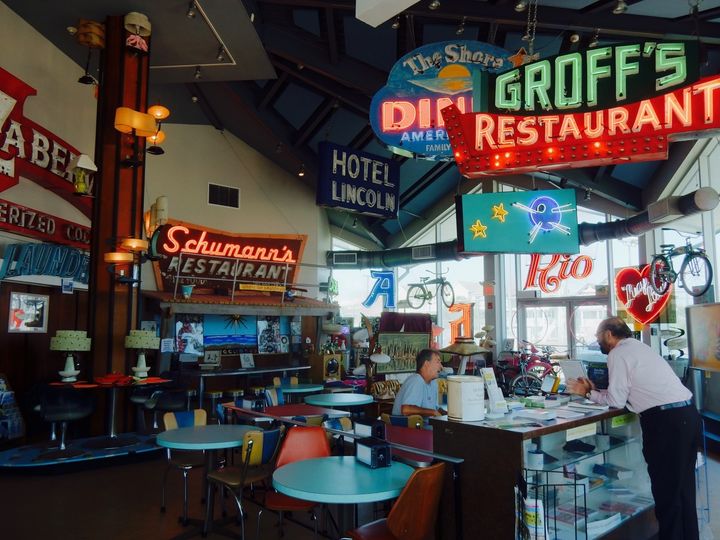
Doo Wop Experience Museum, Wildwoods NJ
Wildwood: Doo Wop Experience Museum. Artifacts of a lost age can be found in this museum - the original Surfside Restaurant - which itself is a 50’s artifact left to rot in a field in Wildwood Crest until the Doo Wop Preservation League rescued it. “Doo Wop,” says Dan McElravey, President of the League, “is a style of architecture, a lifestyle, another word for fun.” Brothers, Wilbert and Bill Morey, founders of Morey Piers Amusement Park, started out building kitschy motels in the 1950’s modeled on those they saw in Florida, with swooping rooflines and kidney-shaped pools. By the late 1990’s, many of these so-called “Doo Wop” style motels were being torn down to make room for condos, inspiring a group of local preservationists to salvage what they could and inspire others to renovate.

Stereopticon at Sparta Historical Society Museum, Sparta NJ
Sparta: Sparta Historical Society Museum at the Van Kirk Homestead. This is no stale and stuffy museum: it’s a vital, enjoyable, beautifully presented and relevant collection of local history. Built in the late 1700’s, the Van Kirk family lived in this two-story homestead until 1996 when most of the property was sold to the Sparta Board of Education to construct the behemoth Middle School right next door. The Historical Society was able to save and restore the Van Kirk house, with a 365-year- old White Oak Tree – the second oldest in the state – shading its roof. Most engaging is the well-preserved Stereopticon in the downstairs Victorian Era Parlor with, as I was told, “some pretty risqué pictures.”
Morristown: Morris Museum. The Morris Museum is a fantastic institution with a Georgian-style mansion encapsulated within a contemporary wing. Yes, it’s got rocks, minerals, mounted birds and mammals, but at 2pm sharp every day, you’ll want to enter the climate controlled galleries housing the unsurpassed 750-piece Murtogh D. Guinness Collection of Mechanical Musical Instruments and Automata. This is when docents demonstrate one or several (among 150 on view) of these feats of orchestral engineering, which also happen to be works of art; most manufactured in the industry’s 19th Century heyday.
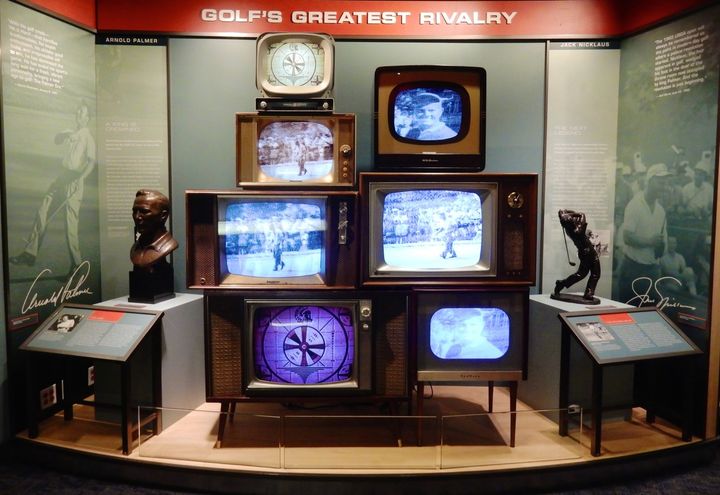
USGA Museum, Far Hills NJ
Far Hills: United States Golf Association (USGA) Museum. Planning a visit to the USGA Museum of Golf while in Northern NJ should be “par for the course.” There is just no better place to learn about golf’s intersection with American history, how it got its foothold in American life, and about its champions than at the USGA Headquarters and Museum, housed in a mansion built in 1919 by a Wall Street stockbroker who escaped here on weekends. Golf enthusiasts have most likely known about this place since the Museum opened in 1936 (predating the Baseball HOF in Cooperstown NY by 2 years), but even if your golf knowledge is sub-par, the exhibits are a great study of this sport loved by plumbers and Presidents alike. Perhaps the most spine tingling artifact is the golf club that Alan Shepard smuggled onto Apollo 14, and swung on the moon.
PENNSYLVANIA

Jimmy Stewart Museum, Indiana PA
Indiana: Jimmy Stewart Museum. Anyone who’s ever felt a jolt of emotion while watching the movie, It’s A Wonderful Life will want to visit this one museum devoted to hometown hero, and all around swell guy, Jimmy Stewart. It figures that the Jimmy Stewart Museum, opened in 1995, shares space with the town Library. After all, humble Stewart himself didn’t want a museum devoted to just him and his movie career, wishing instead to focus on his family, the town, and his service in the Armed Forces during WWII.
Blairsville: Underground Railroad History Center, Blairsville. Located in the 1917 Second Baptist Church, this low-tech, hands on, much-researched one room exhibit illuminates the plight of the enslaved and the gumption of freedom seekers and those who helped them along the way. Blairsville was a canal town, and as such, part of the water-highway to Pittsburgh – rendering it a logical stop on the Underground Railroad. After the Civil War, Blairsville Abolitionist, Alexander Moorhead, Jr., wrote the names of Underground Railroad “Conductors,” stops, and incidents specific to his hometown. In 1858, eight years after the Fugitive Slave Act, allowing slave trackers to find and return freedom seekers from free states, was passed, Blairsville locals formed a mob to drive these slave catchers out of town, saving Richard Newman – who had been living in Blairsville for six years with UGRR conductor, Lewis Johnson. Blairsville’s Fugitive Slave Rescue of 1858 is reenacted annually and still celebrated today.
Saltsburg: Rebecca B. Hadden Museum at 1830 Stone House. Originally a Canal and then railroad stop between Philly and Pittsburgh, Saltsburg once bustled with industry. Though this dusty glass case museum holds lots of local stuff – coal mining artifacts, Native American arrowheads, pictures of floods, and a portrait of Jimmy Stewart painted by his sister, the most fascinating exhibits are about Saltsburg’s namesake – “salt wells” that provided the country with most of its domestic salt. Beginning in 1813, drillers discovered salt deposits 300 feet below ground. Pumped with water, brine was brought to the surface, evaporated, and the resulting high quality salt sold all over the country. In fact, this valley was the 3rd largest producer of salt in the USA with over 21 Salt Works within 2 miles – until the discovery of oil. Another story entirely.
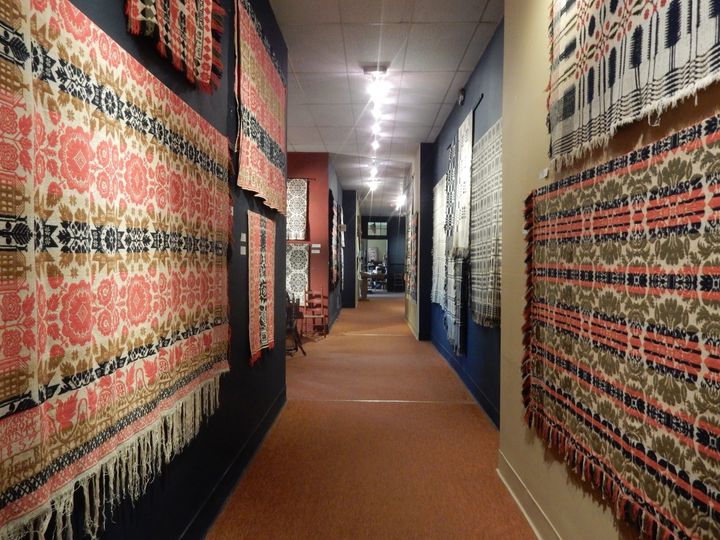
National Museum of the American Coverlet, Bedford PA
Bedford: National Museum of the American Coverlet. Situated in the 1859 Bedford Primary School, this museum is weird and wonderful enough to warrant mention on the Atlas Obscura website. Antique coverlets earn their stripes, so to speak, as an American art form here, displayed in all their magnificence throughout a labyrinth of old classrooms that now serve as soaring galleries. All 500-600 coverlets, dating from 1771 to 1889, are in outstanding shape.
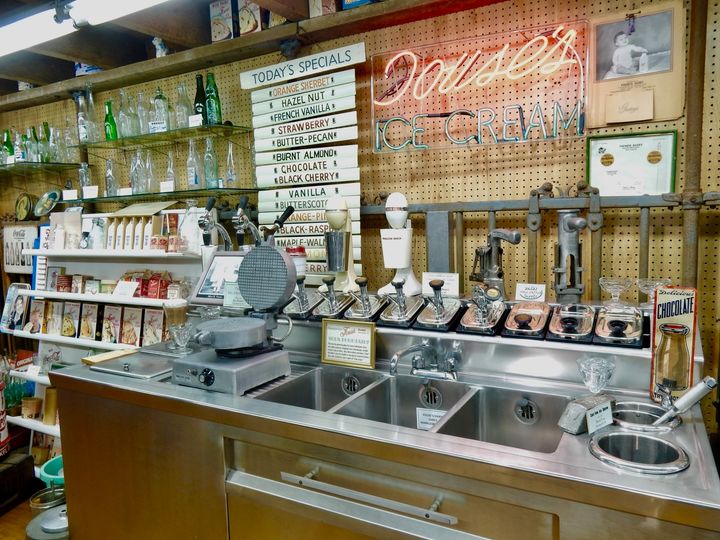
Isett Heritage Museum, Huntingdon PA
Huntingdon: Isett Heritage Museum. Plan two hours or more to see 40,000 objects on display, organized by era, at the surprisingly engaging Isett Heritage Museum. Referred to as the “Smithsonian of Huntingdon PA,” the Isett Museum is a tourist favorite nostalgia trip, showcasing a progression of agricultural tools, electronics, machines, toys, kitchen and home appliances, utensils, complete rooms, and other memorabilia in three large buildings. Founder Mel Isett is still very much involved at age 95. A prescient businessman, who started out “in TV” (he owned the region’s first communications tower), Isett brought Cable to this part of PA in 1960 (with 5 channels: he sold out to Adelphia in 1999).

Mercersburg: Charles T. Brightbill Environmental Center (behind James Buchanan High School). Kids (and many adults) go bonkers in this modest but engrossing Natural History museum with its tantalizing African Mammal Room – curated to appear as if all the mounted creatures in New York’s Museum of Natural History were taken from their dioramas and crammed into one room.
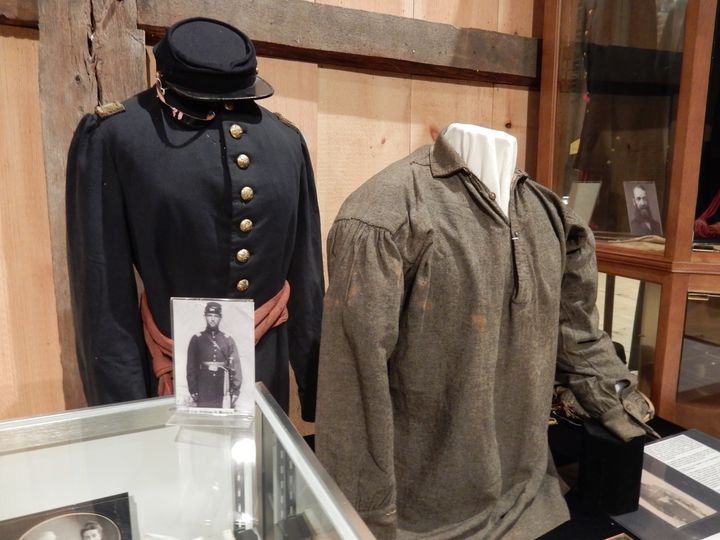
Allison-Antrim Museum, Greencastle MD
Greencastle: Allison-Antrim Museum. For a “hometown” museum, you’ll be mighty impressed, even by the two buildings on an acre of land. The main house was built in 1860 on the eve of the Civil War. The soaring German Bank Barn, originally located in Chambersburg, was deconstructed timber-by-timber, stone by stone, (color coded by cow tags per each of 4 sections or “bents”), and reassembled on this site. Don’t miss the Civil War Exhibit, leavened with human-interest stories. On display is an unwashed shirt with an entry and exit bullet hole in the sleeve. The arm, in this particular case, had to be amputated, and the only regret the wounded soldier had is that he’d lost his wedding ring in the process. Friends plowed through the pile of amputated arms outside, found the one with his ring, and retrieved it for him. The only thing was, the subject of this legend wasn’t married until after the war, rendering this Civil War tale a very tall one.
MARYLAND
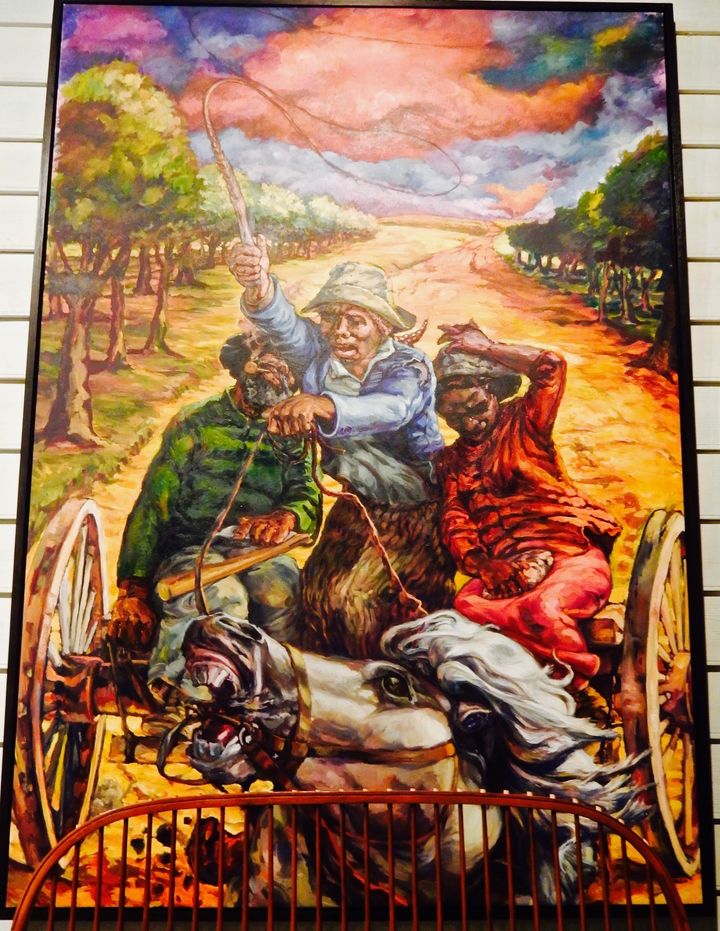
Escape from Poplar Neck, Museum of Rural Life, Denton MD
Denton: Museum of Rural Life. See the original oil of “Escape From Poplar Neck,” the painting of Harriet Tubman and her parents riding for their lives out of Maryland, (a copy hangs in the Harriet Tubman Visitor’s Center in Cambridge) at the modest but worthy Museum of Rural Life. There’s also an actual relocated farm cabin, a parlor from a 1790 home, and a photomural titled the “Seeding of Alaska Peas,” dated March 1906. At one point, Caroline County MD was considered the “Garden of America” and pictures like these remind you of those origins.
Cambridge: Long Wharf and Choptank River Lighthouse. Walk on docks past working watermen boats to get to this replica of a screw-pile lighthouse, built in 2012. The original stood a couple of miles upriver from the 1920’s to the 1960’s, when the Choptank was the “Route 50 of its time” – a transportation artery for oysters, steamboats and rumrunners. Slave ships came up this river from the Chesapeake, one carrying Harriet Tubman’s grandmother, Modesty Green.

Ward Museum of Wildfowl Art, Salisbury MD
Salisbury: Ward Museum of Wildfowl Art. This fantastic museum, a paean to the craftsmanship of carved birds, turns 50 in 2018 (since 1991 in this modern building), and should be a first stop for anyone coming to Wicomico County – even if you don’t know about or believe you won’t enjoy looking at duck decoys. The much praised Ward, in the Chesapeake Bay Watershed, provides an indoor-outdoor experience, examining the cultural traditions of the Eastern Shore and “lifeways” of the Delmarva Peninsula through art, history, nature and community programming.
Taneytown: Taneytown Historical Society. You’ll often discover the essence of a small town at its Historical Society Museum, and Taneytown MD is case in point. On display are two Taneytown-made Eli Bentley clocks; one made exclusively in the late 1700’s for Michael Waggoner, a Revolutionary War hero whose name graces the clock face. That one was purchased at Sotheby’s and donated to the Historical Society, as Bentley lived in Taneytown. The other was donated after serving time in a nearby funeral home for decades. Also exhibited is a rare Mason/Dickson Line marker stone– emblazoned with an M (Maryland) on one side and P (Pennsylvania) on the other.
Silver Spring: See the bullet that killed Abraham Lincoln at the National Museum of Health and Medicine, Silver Spring. Founded by Surgeon General William A. Hammond in 1862, this little known institution highlighted the “Medical and surgical history of the War of the Rebellion.” Now, the Department of Defense’s National Museum of Health and Medicine is tucked away in a modern building behind the U.S. Army Forest Glen Anex. Since 1862, the Museum of Medicine has moved nine times (last located in the now defunct Walter Reed Army Medical Center), until this edifice was built as its permanent home in 2011, and it’s worthy of hours of your time, with thousands of medical specimens from the Civil War to the Iraq War.
Betterton: Betterton Museum at the Town Office, and Betterton Beach. Before the Bay Bridge was built in 1952, and before Ocean City MD became all that, steamer boats and ferries brought thousands of people per day to Betterton Beach. There were 17 hotels, dance halls, and bowling alleys. Now, with a year round population of just 300, the pristine no-sea-nettles beach is quiet and peaceful. Learn local history from the journals of John Smith and other historic figures in this small museum in an old converted Catholic Church (Church of Most Precious Blood) that now serves as Town Offices, Community Center, and the Betterton Historical Society Museum.

Benneker-Douglas Museum, Annapolis MD
Annapolis: Banneker Douglass Museum. Situated in the former Mt. Moriah African Methodist Church, Annapolis’s museum of African American History, named for mathematician Benjamin Banneker (who helped survey the borders of the original District of Columbia), and Abolitionist, Frederick Douglass, is a hidden gem worth at least an hour. Celebrating Fellowship, Worship, and Community, engaging exhibits are now in an adjacent building, and focus on the Black men and women in Maryland history who deserve recognition.
Eastport/Annapolis: Annapolis Maritime Museum. This dockside museum in a residential neighborhood in Eastport was, from 1918 to 1986, the McNasby Oyster Co., the last oyster packing plant in the region. Annapolis has primarily been a yachting/Navy community, but Eastport across the channel identifies as a Watermen’s neighborhood, and this Maritime Museum highlights that industry.
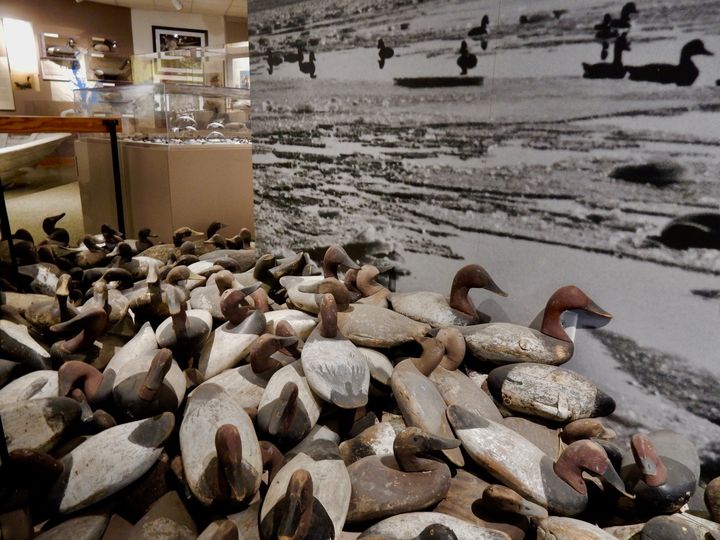
Havre de Grace MD Decoy Museum
Havre de Grace: There are four small museums of note in Havre de Grace. Decoy Museum, situated in the building that once served as laundry, indoor tennis courts and pool for the former Bayou Hotel (now condos) right on the waterfront. Walk in and you’ll immediately see all 260 decoys owned by baseball Hall of Famer – John Franklin “Homerun” Baker – crammed into his “Bushwack” boat. There’s an exact replica of famous carver, Madison Mitchell, at work, a whole multi-media diorama inside a screened-in shack, narrated by Mitchell himself, and more intriguing displays. The 1840 Susquehanna Museum at the Lock House, about a mile from the Havre de Grace’s other museums, contains a very unique working miniature model of a real canal lock – a huge drawing card as no other museum has one of this caliber. As the former home and office of the lock tender and his family, it’s an authentic peek into the lives of those charged with this important task. Havre de Grace Maritime Museum (between the Decoy Museum and Lighthouse). There are petroglyphs, Native American “graffiti, ”on rocks coughed up by dynamite during the construction of the Conowingo Dam; crab pots and nets; Chesapeake Bay boats; a ships bell, crusted with fossils, scavenged from the bottom of the ocean floor in New Jersey waters; a ship Captain’s office, and a whole exhibit devoted to John Smith’s Aug 2-6, 1608 exploration of the Chesapeake Bay – one of the richest and most productive estuaries in the world. Concord Point Lighthouse and Keeper’s House. When canning and fisheries in Havre de Grace became highly profitable, boat traffic increased on what was then known as the Susquehanna Flats. The lighthouse, built in 1827, had to be situated on this valuable commercial stretch of shoreline, but the Keeper’s House was forced to stand yards away (now across the street). Both are open to the public.
Havre de Grace: Steppingstone Farm Museum. It’s a bit of a drive to this hodgepodge of buildings on stunning property overlooking the Chesapeake Bay. Born from the mind of J. Edmund Bull, who saw this institution as a “Stepping Stone to the Past,” the property encompasses ten buildings – the oldest a 1771 stone home original to the site – on what was a 2,000 acre estate. Though the structures are interesting, many people come for weddings here – or just to picnic and take in the views.
VIRGINIA
Fairfax: National Firearms Museum at NRA Headquarters. If you want to see the mother-of-pearl pistol and carved wood shotgun used by Annie Oakley in Buffalo Bill Cody’s Wild West Show, if you’d like to peek at the exquisite handiwork of the gold-embossed 1800 Fatou Flintlock Double Barrel Fowler commissioned by Napoleon Bonaparte, or one of 75 guns used by John Brown at Harpers Ferry, if you’ve got any appreciation for the Smith and Wesson that Clint Eastwood carried in the movie, Dirty Harry or his M-1 from Gran Torino, if you want to see the tiniest pistol in the world in working order, a finely filigreed “Colt Vampire Gun” in its coffin case, or the largest exhibit of Gatling Guns in the world – if you are curious about the history of firearms at all – this larger than it first looks collection of guns spanning 700 years in 15 galleries, is worth an hour, at least.
Lynchburg: Lynchburg Museum. Desmond Doss, the pacifist-medic whose story was told in the blockbuster movie, Hacksaw Ridge, was from Lynchburg. Ota Benga, a Congolese Pigmy exhibited in the Monkey House of the Bronx Zoo in the early 1900’s, was rescued by faculty at the nearby Virginia Seminary and brought to Lynchburg. Discover more about Lynchburg VA at this well-designed three-story museum that opened in 2008 inside the 1855 Lynchburg Courthouse at the tippy top of Monument Terrace.
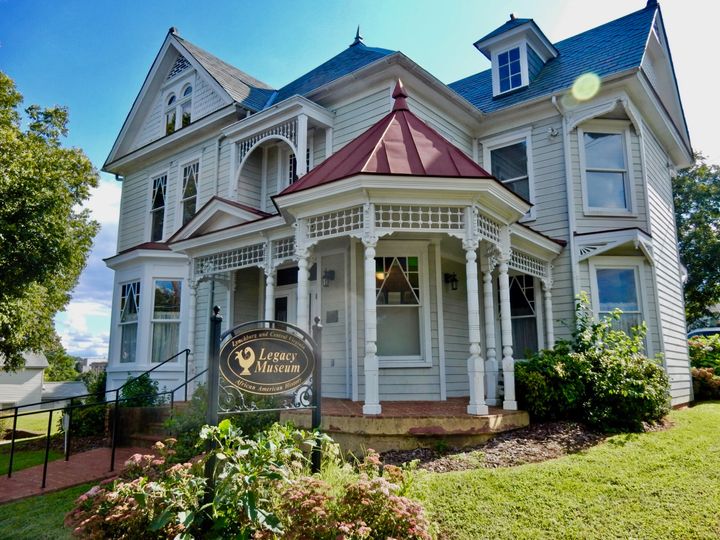
Legacy Museum, Lynchburg VA
Lynchburg: Legacy Museum of African American History and Art. This small three-gallery museum showcases the best of local African American history and art. Opened in 2000 with an exhibit on health and medicine, with subsequent exhibits on Blacks in the military, life during Jim Crow, and others, it is currently displaying unique and avant garde art. The Legacy often hosts music and other events on the lawn – so check the website, and definitely drop by.
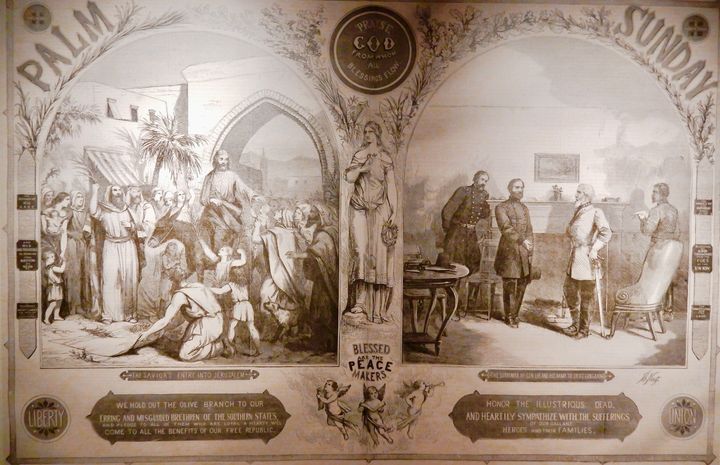
Palm Sunday sentiments after Lee surrendered to Grant, American Civil War Museum, Appomattox VA
Appomattox: American Civil War Museum. Appomattox is less than 30 minutes drive from Lynchburg, and this museum, two miles from the place where Robert E. Lee surrendered to Ulysses S. Grant, is a must-do if only to witness how this southern museum has changed its message over the last couple of years. Formerly the Museum of the Confederacy, the American Civil War Museum showcases what was going on in hearts and minds on both sides of the conflict through a succession of banners and readings from diaries of the day. First fire at Fort Sumter on April 12, 1861 “brought hope to slaves.” Confederates responded, “Any fate but submission.”
Chantilly, Dulles Airport: Steven F. Udvar-Hazy National Air and Space Museum. The Enola Gay, the B-29 Superfortress Bomber that dropped an Atomic Bomb on Hiroshima, is but one of the “Big Five” historic aircraft housed in this lesser known but larger-than-its-DC-cousin Smithsonian Air and Space Museum. And though the aviation hanger-sized galleries are packed with an overwhelming number of commercial and military aircraft, and the museum itself has been touted by Virginia.org as “The Best Place to Get in Your 10,000 Steps,” you can narrow down your visit to an hour by seeking out the five most significant pieces of flying history. There’s the Boeing 707 Dash-80, considered the first commercial passenger jet (not the first commercial prop plane, however), the first Concord, which was fast but much too expensive for commercial use, the all titanium SR-71 Blackbird, the fastest flying machine in the world, which made it from L.A. to Washington DC in 1 hour 4 minutes, 20 seconds, and, in a hangar all its own, the Space Shuttle Discovery – the most WOW of all.
